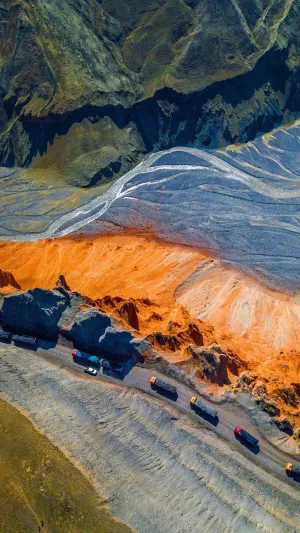Canyons are one of nature's most awe-inspiring wonders, carved over millennia by the relentless force of fast-moving rivers.
These majestic landscapes are often formed by long-term erosion at plateau levels, where hard rock resists erosion and weathering, leaving behind exposed, dramatic cliffs.
The result is a breathtaking combination of size and beauty, often hidden away in the most unexpected places.
Here, we introduce you five awe-inspiring canyons, which provide excellent scenery to you.
<h3>1. Kuitun Grand Canyon, China</h3>
The Kuitun Grand Canyon, located in Xinjiang, China, is a testament to nature's incredible power. Situated 18 kilometres from the city, this canyon was sculpted by the natural erosion of snowmelt over thousands of years.
The valley runs north-south, stretching about 20 kilometres in length, with a valley floor that ranges from 100 to 400 meters in width. The canyon's most dramatic drop plunges 200 meters deep.
Despite being featured in National Geographic magazine over two decades ago, the Kuitun Grand Canyon remains largely undeveloped, preserving its pristine and desolate beauty. The only way to reach the bottom is by road, making the journey an adventure in itself. Its remote and untouched nature adds to its allure, drawing international visitors who seek to experience its raw, unspoiled magnificence.
<h3>2. Fish River Canyon, Namibia</h3>
The Fish River Canyon in Namibia is another of the world's grand natural spectacles. Renowned as one of Namibia's most popular tourist attractions, this canyon is truly magnificent and breathtaking.
It stretches approximately 160 kilometres in length, and 27 kilometres in width, and plunges nearly 550 meters deep. The Fish River, which is dammed, now contains only a small amount of water, but this does not detract from the canyon's dramatic appearance.
Visitors to the Fish River Canyon are often left in awe of its sheer scale and rugged beauty. The canyon's stark, arid environment contrasts sharply with the lush, subtropical landscapes of other canyons, offering a unique and striking visual experience. It is a place where the power of natural forces is on full display, and its raw, rugged beauty is unforgettable.
Fish River Canyon, Namibia
Video: Kangela Explores
<h3>3. Blyde River Canyon, South Africa</h3>
The Blyde River Canyon in South Africa, though not the largest in the world, stands out for its exceptional preservation and stunning subtropical vegetation. Spanning 16 miles in length and averaging about 2,500 feet in depth, this canyon is a remarkable testament to the beauty of nature.
From the edge of the Blyde River Gorge, visitors are treated to some of the most incredible views in South Africa. The canyon's lush, green landscapes are home to a rich variety of flora and fauna, including all five species of South African primates.
This biodiversity, combined with the canyon's dramatic scenery, makes it a must-visit destination for nature lovers and adventurers alike.
<h3>4. Waimea Canyon, Hawaii</h3>
Waimea Canyon, often referred to as the "Grand Canyon of the Pacific," is one of Hawaii's most renowned natural wonders. Stretching 14 miles, this canyon offers a unique landscape not found anywhere else in the region. Mark Twain once called it the "Grand Canyon of the Pacific," a fitting tribute to its stunning beauty.
From the viewing platform, visitors can enjoy unobstructed views of mountains, cliffs, and canyons. The scenery is spectacular, with a group of five waterfalls adding a lively touch to the serene valley.
As you explore the canyon, you'll encounter a diverse array of tropical plants, some of which you may have never seen before. Waimea Canyon is a place where the beauty of nature is on full display, offering a rich and immersive experience for all who visit.
<h3>5. Grand Canyon, USA</h3>
The Grand Canyon in the USA is perhaps the most famous of all canyons and a true natural wonder. Known for its immense size and intricate, colourful landscape, the Grand Canyon is a UNESCO World Heritage site.
The canyon stretches 446 kilometres in length, with its deepest point reaching about 1.6 kilometres, equivalent to approximately 500 stories high. The rocks at the valley floor are about 2.1 billion years old, representing nearly half the age of the Earth.
The Grand Canyon is a place where visitors can truly appreciate the power and beauty of natural erosion. The Colorado River, which runs through it, has carved this majestic landscape over millions of years, creating one of the most iconic and breathtaking views on the planet.
The Grand Canyon remains a symbol of nature's grandeur, attracting millions of visitors from around the world each year to witness its unparalleled beauty.





